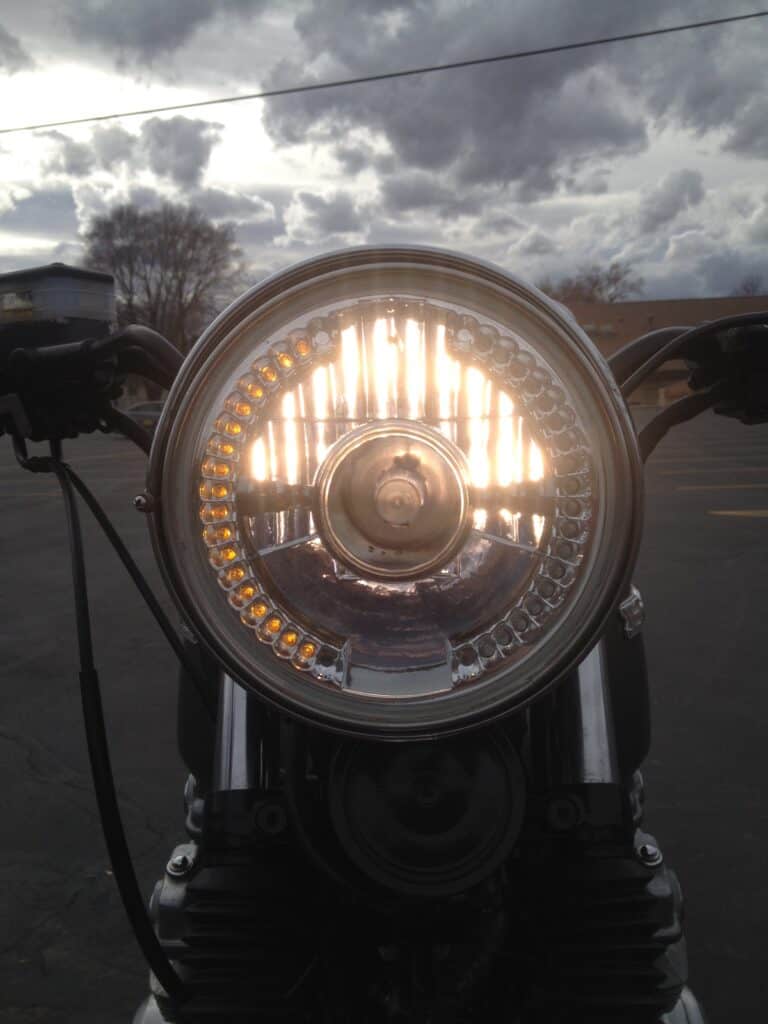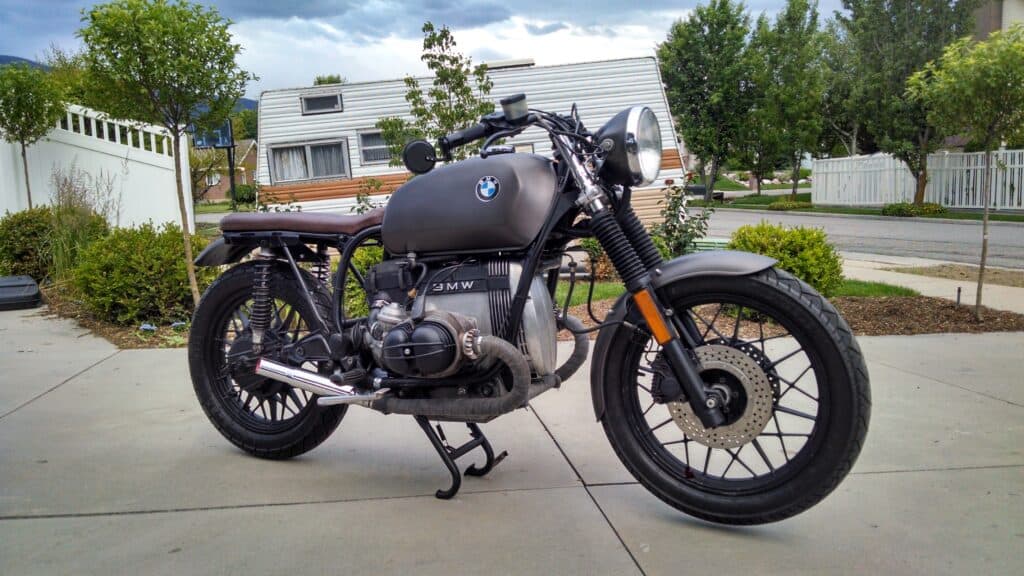
Have you ever been on the road and noticed a motorcycle’s lights flashing or flickering?
Many wonder if the motorcyclist is doing that on purpose or if there’s some sort of electrical problem going on with the bike. Either way, it’s a curious phenomenon and deserves an explanation for motorcyclists and non-riders alike.
Why do motorcycle lights flash and flicker? The most common reason why motorcycle lights flash and flicker is because the motorcyclist has installed a light modulator. This is a device that flashes either the headlight or the taillight to help them become more noticeable to other drivers around them. If the flashing has no pattern, the motorcycle likely has an electrical issue.
As a motorcyclist myself, I have a full appreciation and understanding as to why this happens and I’d love to shed some light to those who would like to know more. Knowing the causes behind this phenomenon can help riders and motorists alike navigate the roads more safely. Join us as we explain this intriguing aspect of motorcycle lighting systems.
Flashing Lights On A Motorcycle And Why It’s A Thing
There’s always at least a little bit of risk getting in a vehicle and driving down the road. But most of us do it every day and don’t really think about those risks we take. For motorcyclists, it’s a bigger risk because they’re much less protected on their bike. It’s no wonder they try to take extra measures to ensure their safety.
Seeing flashing lights on a motorcycle is a curious thing. For some, it can be startling because they associate it with an emergency. But the main reason motorcycle lights flash is to let other drivers around them know they are present and to proceed with caution when driving by them.
The best way for motorcyclists to do this is by installing a light modulator. This is a device installed directly into the electrical wiring of the headlight and the brake light. The modulator makes the headlight flash in a rhythmic pattern so oncoming traffic becomes more aware that they are about to pass a motorcycle. The motorcyclist has the option to turn this on or off on the modulator throughout the day.
This devices doesn’t make the brake lights do a continuous flash, rather they make the brake lights flash around five times when the motorcyclist is braking.
Motorcycle brake lights are much smaller compared to car brake lights, so it can sometimes be difficult for vehicles that are behind the motorcycle to see that the motorcycle brakes are being applied. The flashing will ensure the driver behind knows that the rider is slowing down.
There are some motorcycles out there that have flashing lights for other reasons outside having a modulator installed. If you notice a motorcycle’s lights flashing in a non rhythmic pattern, the motorcyclist might be trying to get your attention for emergency purposes.
It’s also possible that the motorcycle has some sort of electrical issue that may cause the lights to flicker. Perhaps there is a wire that isn’t fully connected or poor splicing was performed which would manifest itself any time a motorcyclist went over any sort of bump.
Is This Legal?
The next biggest question most people have about motorcycle flashing lights is whether or not it’s legal. It can sometimes be distracting for other drivers, so many people assume it isn’t. Having installed a modulator on one of my motorcycles, a 1981 CB750, I can confidently report the legality of it all.
In actuality, as long as the motorcyclist is correctly using the light modulator on their motorcycle, it’s completely legal in all 50 states in the U.S. In fact, it’s a federal law that state laws cannot supersede. United States law recognizes how susceptible motorcyclists are and encourage bikers to use subtle but effective ways to get them more noticed on the road.
There are still laws that need to be heeded if a motorcyclist is going to install a modulator on their motorcycle. First and foremost, they need to install a modulator that is government certified and can’t simply make their own modification.
The headlights of the motorcycle needs to be positioned in a way that is somewhat facing down and not gazing straight at the oncoming traffic. Having the wrong position of the headlight could lead to a ticket or fine since that’s extremely distracting for those who pass them.
Flashing lights are also not permitted during the night. Government approved modulators for motorcycle headlights will already have a sensor on them that will turn off the flashing when it starts getting dark. Again, flashing lights during the night can be incredibly distracting for other drivers since modulators alternatively use the high beam and low beam in it’s flashes.
Flashing Lights Effectiveness

According to a study done at the National Academy of Sciences, Engineering, and Medicine, “the failure of motorists to detect and recognize motorcycles in traffic is the predominating cause of motorcycle accidents.” Motorcyclists don’t want to become a victim of being unseen, so some do all they can to make themselves noticeable on the road.
The study also goes on to say that the most common scenario for motorcycle accidents happens in intersections when cars are turning and don’t see a motorcyclist in oncoming traffic. In this same study, it concluded that using a detectable headlamp is highly effective with preventing motorcycle accidents.
In addition, the study also concluded that increased contrast in conspicuity is a simple countermeasure for motorcycle accidents. Had some of those cars seen flashing headlights, perhaps the accident would have been prevented.
Having flashing lights, whether it be the headlights or the brake lights, can also help a motorcyclist feel more confident while they’re out riding. A confident motorcyclist is likely to be a more defensive rider which, in turn, could mean less accidents for them altogether.
Many motorcyclists have stated they feel more safe while using a light modulator on their motorcycle. Despite some of the comments they may get from other drivers who are annoyed with their flashing lights, motorcyclists say they’d rather have someone be annoyed with their lights than not notice them at all.
Some Of The Setbacks
Though having flashing lights on a motorcycle can have a positive impact on the rider’s safety, there are a few setbacks that both motorcyclists and drivers alike have complained about.
The first setback is when motorcyclists use their modulator at night and continue to have flashing lights when it’s dark. While this isn’t much of a problem with the taillight/brake light, the headlight flashing at night becomes problematic. Since it switches between high beam and low beam, the high beam can often be distracting to other drivers. This is why modulators should only be used during the day.
Another problem that arises from flashing and flickering lights from a motorcycle is that drivers often assume the motorcyclist is trying to communicate something to them and pull over. Or they may assume the motorcycle is some sort of emergency vehicle and possibly raise a panic.
Most drivers simply get annoyed by the flashing lights. A lot of drivers are unaware that these lights are completely legal (when used in compliance) and will sometimes try to contact authorities to report the motorcyclist. Even some authorities are unaware of the rule.
Conclusion
The flashing and flickering of motorcycle lights can stem from various factors, including the installation of modulators or electrical problems. Installing modulators to intentionally make the head or taillights flash on a motorcycle is not only illegal, but encouraged on a federal level.
Regardless of the reason, understanding why motorcycle lights flash and flicker can contribute to safer road experiences for both riders and motorists.
